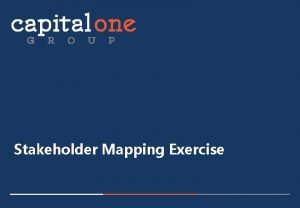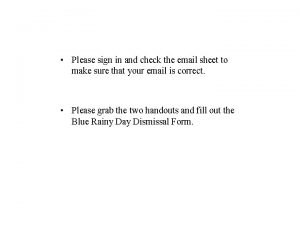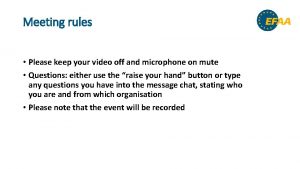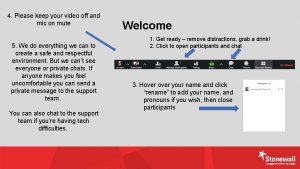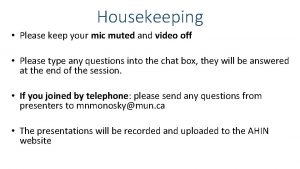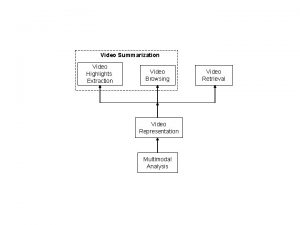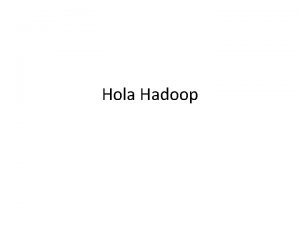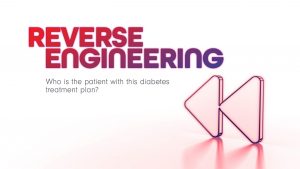Welcome 4 Please keep your video off and































- Slides: 31

Welcome 4. Please keep your video off and mic on mute 5. We do everything we can to create a safe and respectful environment. But we can’t see everyone or private chats. If anyone makes you feel uncomfortable you can send a private message to the support team. You can also chat to the support team if you’re having tech difficulties. 1. Get ready – remove distractions, grab a drink! 2. Click to open participants and chat 3. Hover your name and click “rename” to add your name, and pronouns if you wish, then close participants

MONITORING EQUALITIES DATA TO SUPPORT YOUR WORK WEI support series: part 3

Cake Bennet Client Account Manager Pronouns: they/them Jaipreet Deo Client Account Manager Pronouns: she/her

Welcome! • Please make sure your microphone is muted and your camera is turned off • There will be time for questions at the end of the session – please add questions in the chat throughout, but be mindful that the Q&A will be around 10 minutes and we may not have time to answer all questions • We do everything we can to create a safe and respectful environment – if anyone makes you feel uncomfortable you can send a private message to the support team • You can also chat to the support team if you're having tech difficulties

Session Outline • Introduction to the section • Best practice questions • What we look for and common challenges • Overcoming restrictive frameworks • Q&A

Section 6: Monitoring • How do you use monitoring to understand the representation and experiences of your LGBT employees? • Gender, trans status and sexual orientation • Data collection methods, analysis and actions, boosting declaration rates

Best practice question: gender What best describes your gender? • Man • Non-binary • Woman • I use another term: ____ • Prefer not to say

Best practice question: trans status Are you trans? • Yes • No • Unsure • Prefer not to say

Best practice question: sexual orientation What best describes your sexual orientation? • Bi • Gay/Lesbian • Heterosexual/Straight • I use another term: ____ • Prefer not to say

6. 1 Does the organisation gather data on employee sexual orientation through diversity monitoring forms and/or systems? If yes, what proportion of employees have answered this question on your HR system? What we are looking for • That you monitor sexual orientation using a robust, correct question • The pasted/written out question you use on the majority of systems which collect diversity info Best practice What best describes your sexual orientation? • Bi • Gay/lesbian • Heterosexual/straight • I use another term: _____ • Prefer not to say

6. 1 – Common challenges • 'Bisexual’ or ‘bi+’ is used • The ‘I use another term’ option is available, but without an open text box • Options are not listed alphabetically (excluding prefer not to say) • No analysis report uploaded or robust completion measurement described • No bi inclusive OR 'I use another term' option • Gendered options – e. g. ‘Gay man’ or ‘gay women/lesbian’ • Conflating SO and GI in the question e. g. having trans as a tick box for SO • Any discriminatory or harmful language/options • Sharing confidential employee data

6. 2 Does the organisation gather data on employee gender, inclusive of non-binary identities, through diversity monitoring forms and/or systems? If yes, what proportion of employees have answered this question on your HR system? What we are looking for • That you monitor gender using a robust, correct question • The pasted/written out question you use on the majority of systems which collect diversity info Best practice What best describes your gender? • Female • Male • Non-binary • I use another term: ______ • Prefer not to say

6. 2 – Common challenges • There is no ‘non-binary’ option (would still award if an open text option is provided) • ‘I use another term’ option available, but without open text box • Options are not listed alphabetically (excluding prefer not to say) • No analysis report uploaded or robust completion measurement described • The question asks about sex rather than gender • There is no ‘I use another term’ option (even if non-binary is listed) • If the question makes a distinction between trans and cis people • Any discriminatory or harmful language/options • Sharing confidential employee data

6. 3 Does the organisation gather data on employee trans status through diversity monitoring forms and/or systems? If yes, what proportion of employees have answered this question on your HR system? What we are looking for • That you monitor trans status using a robust, correct question • The pasted/written out question you use on the majority of systems Best practice Are you trans? • Yes • No • Unsure • Prefer not to say

6. 3 – Common challenges • There is no ‘unsure’ option • ‘Do you consider yourself to be trans? ’ or ‘Do you identify as trans? ’ • ‘Is your gender the same as the sex you were assigned at birth? ’ • No analysis report • No robust completion measurement • The data is not collected through an HR system • Any discriminatory or harmful language/options e. g. use of ‘transsexual’ • Sharing confidential employee data

6. 4 Does the organisation monitor and analyse success rates from application to appointment across the following characteristics? Sexual orientation; Gender; Trans status; None of the above What we are looking for • Reports or analysis that demonstrate the success rate of applicants by sexual orientation, gender (including non-binary identities) and trans status • If there is too little data to analyse (and it says that in the report/analysis) marks can still be awarded • Only eligible for marks if acceptable question wording was evidenced and awarded in earlier questions

6. 4 – Common challenges • Action isn’t nuanced e. g. specific work for bi/non-binary/multiple marginalised identities • Analysis of bi applicants (immediately) split by identity • No non-binary option was available • No description of subsequent action taken (or explain why no action was necessary) • Data collection starts at a later stage than application, or finishes at an earlier stage than appointment • Analysis is done as a single block (unless made clear this is due to small data sets) • Gendered analysis • Sharing confidential employee data

6. 5 Does the organisation monitor and analyse the number of employees at different pay grades across the following characteristics? Sexual orientation; Gender; Trans status; None of the above What we are looking for • Analysing the spread of staff across different pay grades and levels within the organisation, cross-tabulated against orientation, gender identity (including non-binary gender) and trans status • If there is too little data to analyse but the data has been collected, make that clear in your response

6. 5 – Common challenges • A one-off ‘snapshot’ exercise from the last two years rather than ongoing data • If the monitoring system is different to that shared in 6. 1 -6. 3 without an explanation • Analysis and action taken isn’t nuanced • No description of action taken (or explain why no action was necessary) • If the question or options analysed would not be awarded a mark in 6. 1 -6. 3 • Analysis is done as a single block • Analysis is immediately split by gender/only includes binary genders • Sharing confidential employee data

6. 6 When running staff satisfaction surveys, does the organisation break down and analyse the satisfaction of employees by the following characteristics? Sexual orientation; Gender; Trans status; None of the above What we are looking for • Analysis of the satisfaction of LGBT staff within their staff surveys • Attaching monitoring/diversity forms to anonymous staff surveys • Data should be anonymised – but still clearly collected Best practice: Separately analysing and taking action specifically on the basis of monitoring: • Bi identities/non-binary identities/multiple marginalised LGBT identities, e. g. , LGBT POC

6. 6 – Common challenges • Analysis more than a year old • Analysis conducted more than two years ago • No description of action taken (or explain why no action was necessary) • If the question or options analysed would not be awarded a mark in 6. 1 -6. 3 • Analysis is done as a single block • Analysis is immediately split by gender/only includes binary genders • Sharing confidential employee data

6. 7 Which of the following activities has the organisation carried out in the last year to improve confidence in LGBT monitoring and boost declaration rates? What we are looking for A: Communicated why LGBT monitoring matters • Shared written content or resources with all staff • Benefits of monitoring for LGBT people and all employees • Promote the uptake rate to encourage staff to take part B: Provided information about confidentiality and data security • Reassure employees data is held confidentially, and explain how this is done • Explain how data is processed

6. 7 Which of the following activities has the organisation carried out in the last year to improve confidence in LGBT monitoring and boost declaration rates? What we are looking for C: Communicated how previous monitoring exercises have led to improvements • A statement that a problem was identified in an LGBT monitoring exercise • Decisions taken by D&I, HR, or E&D team • E. g. introducing gender-neutral toilets, increase or retention of LGBT equality training Best practice A-C: • A well-designed campaign involving graphic and physical resources • Taking an approach to overcome a specific challenge in reaching staff • Taking an intersectional approach to campaign

6. 7 Which of the following activities has the organisation carried out in the last year to improve confidence in LGBT monitoring and boost declaration rates? What we are looking for D: Provided a definition of ‘bi’ that is explicitly inclusive of pan and queer identities E: Provided a definition of ‘trans’ that is explicitly inclusive of non-binary identities • Definition/ links to a glossary with an explicitly inclusive definition of ‘bi’ and ‘trans’ • A statement linked to monitoring form or distribution system that includes that definition Best practice • Data collection which allows less represented LGBT employees to be reflected in monitoring forms • Appropriately analyse the data e. g. Data of staff identifying as non-binary but not trans

6. 7 – Common challenges • Communications give an explanation relevant to LGBT people, but provide no nuance • Communications are only shared/made available to LGBT network group members • Communication doesn’t explicitly focus on LGBT monitoring • Not clear in the communication how actions resulted from a monitoring exercise • Definitions are incorrect or not inclusive • Sharing confidential employee data

Overcoming restrictions – system or sector limitations Check if existing questions can be expanded upon • Though some bodies may not recommend it, they may still be open to you adding these options Acknowledge and monitoring restrictions to employees • If you can't expand on options, the limitations should be explained. Make your commitment to LGBT inclusion clear for all identities and explain what you are doing to remove restrictions Carry out additional monitoring exercises • If required to use non-inclusive questions, you can add more inclusive questions into other surveys Ask for change • Work with organisations in your sector to make the case to your governing body that inclusive equalities monitoring is crucial for employees and the organisation.

Overcoming restrictions – interaction with payroll requirements • Where gender data must be collected in a binary way, we recommend collecting it separately to your other monitoring exercises • This only needs to be done once, when a new employee is first set up for payroll • You should acknowledge these limitations and provide clear information about confidentiality • When potential employees apply for a job, inclusive gender options should be provided • When staff surveys and monitoring forms are completed, inclusive gender options should also be provided

Overcoming restrictions – interaction with gender pay gap reporting • Larger organisations are required to publicly report on differenced in pay between men and women within their organisation • This is restricted to reporting on binary genders, excluding non-binary employees • This causes unreliable data – employers should establish methods to enable all employees to confirm or update their gender • Employers can collect additional data to payroll data – reflecting all employees' lived gender • Leading organisations use their platforms and influence to encourage systems to be inclusive of non-binary people

Resources

Q&A

Thank you
 Please mute your microphone
Please mute your microphone Please turn off the microphone
Please turn off the microphone Please turn off your cell phone in church
Please turn off your cell phone in church Please turn off your cell phone announcement
Please turn off your cell phone announcement Please extend your warm welcome
Please extend your warm welcome I hope you enjoyed your vacation.
I hope you enjoyed your vacation. Parents promoters apathetics defenders
Parents promoters apathetics defenders Stakeholder matrix
Stakeholder matrix Keep it secret keep it safe
Keep it secret keep it safe Will you please be quiet please themes
Will you please be quiet please themes Keep these hands off propaganda poster
Keep these hands off propaganda poster Can you please turn off
Can you please turn off Please switch off the phone
Please switch off the phone Please watch this video
Please watch this video Welcome please take a seat
Welcome please take a seat Welcome please sign in
Welcome please sign in Elbows off the table fingers off the food song
Elbows off the table fingers off the food song Videos yandex search
Videos yandex search Gravity yahoo
Gravity yahoo Yahoo search videos
Yahoo search videos Digital media primer
Digital media primer Please come in and have a seat
Please come in and have a seat Hey hey people
Hey hey people Ladies and gentlemen your attention please
Ladies and gentlemen your attention please Please put away your books and come here
Please put away your books and come here Please raise your right hand and repeat after me
Please raise your right hand and repeat after me Sit on your seat
Sit on your seat Wise men three clever are we
Wise men three clever are we Keep our city clean
Keep our city clean Andy grammer keep your head up download
Andy grammer keep your head up download Kcf method
Kcf method Jrotc uniform male belt
Jrotc uniform male belt






